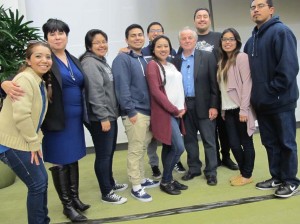L.A. Times Photographer Documents New ‘Harvest of Shame’ in Mexico

When Los Angeles Times photojournalist Don Barletti lectures on his work, there is a deep passion in his voice, and he pays careful attention to the details in each of his photographs.
Bartletti spoke to a packed audience of students and faculty on Feb. 24 at Cal State San Marcos’ Student Union. The theme was a three part series on child labor in Mexico called “Product of Mexico” that he co-produced last December with L.A. Times journalist Richard Marosi.
Barletti’s lecture was presented as part of CSUSM’s College of Arts, Humanities and Social Sciences’ “Engage in Diverse Dialogue Initiative.”
“The purpose of our series was to show how the produce we consume in the U.S. is picked—how the migrant workers live,” said Barletti. The workers told us that representatives from Wallmart, Whole Foods and the Olive Garden came to the farms and green houses. But they never visited the workers.”
Bartletti spoke of his dedication to his craft and the tough, sometimes dangerous experiences he has had covering immigration, drug trafficking and other hot button topics that both bind together as well as divide Mexico and the U.S.
Bartletti gew up in Vista, Calif. After graduating from Palomar College he worked on several North County newspapers, including the Vista Press. On one occasion he was invited to photograph children at an orphanage in Tecate.
“Afterwards I got a call that several of the kids were immediately put up for adoption after they saw their pictures,” he said. I realized that my photography could have an impact. That changed everything.”
For the Times series Bartletti and Marosi traveled to nine states in Mexico. In his talk, Bartletti focused on 12-year-old Alejandrina Castillo, her mother and baby brother.
In photo montages and two videos, he explained how he was able to gain the confidence of the workers and take poignant photos of their everyday lives and those of other migrant children.
These people, said Bartletti, enjoy none of the benefits of workers in industrialized countries like the United States. “They have no access to food, rest periods, water, child care or toilet facilities in the fields,” he said.
A few of Barletti’s photos of the Castillo family are quite poignant. Alejandrina stands on the bed of a pickup, looking back longingly at a school girl in uniform with her backpack. “I want to go back to school,” she said. “I only made it to the third grade.”
In another photo, Alejandrina works a furrow picking chile peppers. Within sight is her baby brother sleeping in a tomato crate, his mother working nearby. In other photos, there are children who have made their own toys—a basketball hoop fashioned from a tomato bucket and a kite made form a plastic garbage bag.
Bartlett’s aerial photos show the stunning immensity of Mexicos’ agribusiness complexes in Sinaloa, with miles of rows of state of the art green houses, interspersed with corrugated shacks for the workers. They are crowded 10 to a room without air conditioning in the tropical heat. The camps are surrounded by barb wire.
“You wouldn’t know this was the 21st century,” he added. “It was more like the Middle Ages.”
According to Barletti’s and Marosi’s series, more than 100,000 children under 14 pick crops for pay in Mexico, roughly seven to 12 dollars a day, even though it is illegal to employ children under 15 years of age.
Another sequence of photos follows Alejandrina and other migrants as they make their way south to a new harvest in Guanajuato. Shots of trucks loaded beyond capacity with workers are reminiscent of the Joad family’s travels to California in John Steinbeck’s Grapes of Wrath.
Following his lecture, students and faculty members queried Barletti about the difficulties of interviewing workers and getting past security guards on the large industrial farms.
“We had to make sure to get permission when we needed to, and to leave when asked,” he said. ‘’Any kind of misrepresentation could have jeopardized the whole series. The growers have teams of lawyers. One has to be very careful.”
Reactions to the lecture were positive. Caroline Theiss-Ard of the North County Immigration Task Force said that people are disconnected from food, who grows it and picks it. “They fail to see why people immigrate to this country. Seeing his beautiful photos – you get a real sense of how brutal life is—how low the pay. Then you can make the connection.”
Dr. Fredi Avalos, who introduced Barletti, said she wanted the students to understand the political, ethnic, religious, economic and sometimes gritty realities of globalization. “We want them to consider how the choices we make on a daily basis, from the clothes we wear to the food we eat have rippling consequences, most of which are invisible to us.”





